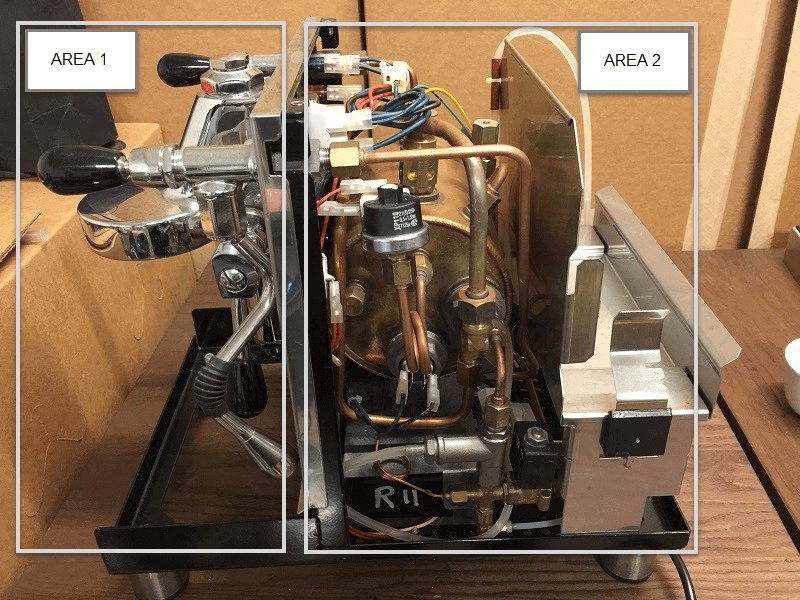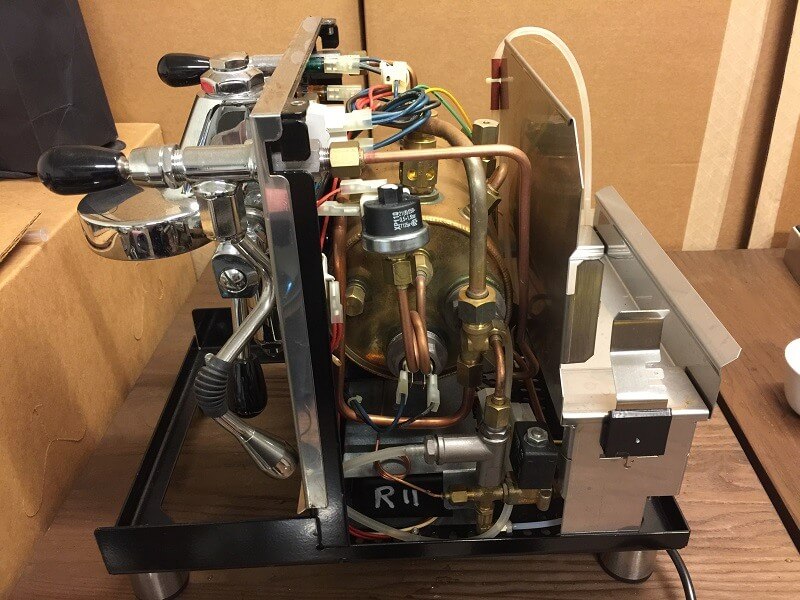Espresso machine for maintenance?
This is quite a lengthy read but I suggest users read at least once in your life because the information might not be available elsewhere. When should you send your machine for service and how much will it cost? There is never a clear cut answer to that.
The answer will largely depend on the condition of water you are using, as in how hard is the water. The amount of usage, how well the owner maintains the machine by softening their water and flushing their groupheads regularly. All these will decide the status of the machine. Also how mission critical is the machine? Some process of maintenance, like descaling, may cause as much harm as good it can do the machine. As such, it’s not always better to over-service the machines unnecessarily.
The below information will elaborate more on the whats and whys.
Maintenance on which parts?
We will divide the machine into two main areas.

- The front area of the espresso machine, consists of the grouphead and the steam wands.
- The internal water circuitry system, which consists of the pressure controllers, regulators, pump, heating element, water probes, relief valves and more.
Normally it’s (1) that gets the most wear and tear as that’s where the user will handle a lot. The gaskets will harden, gears might wear out, the chambers clogged. If you are having problems with wear and tear within this area, that’s a big relief, because it’s usually easy to fix. Basically, replacing with new parts, clean the chambers, replace the gaskets, etc. It might take some time, but it’s largely solvable. It’s hard to say when you really need to do maintenance for this section, we will say do it only when it’s necessary. Most users buy components and fix it themselves, especially for the commercial environment. Operators normally rectify the problem as soon as possible, than to arrange for the machine to be sent back for the repair. if you need our services, please refer to the following page: Maintenance Service (For Semi-Professional Espresso Machines)
Most don’t consider much about Part (2) which is the water circuitry system. That is the biggest folly. The problem with the water circuitry system is often due to the formation of limescale. To know more, please refer to the following: Water Softening.
Limescales are basically solid particles formed from the minerals in the water. The harder is your water, the more it can form. Limescale can form in any types of espresso machines, including automatic machines sold in most electromarts. Limescale is the biggest bane to the espresso machine and is often the cause of most technical issues. It is like cancer to the espresso machine which directly affects its longevity.
If you have a limescale problem, then you will have a big headache and you will need to make a lot of hard decisions to make, often with expensive repairs.
What’s the potential cost?
If you are talking about doing maintenance on part (1). We will say, you can get it fixed within 1%-20% of the cost of the machine depending on whether you want to DIY or get someone to fix it. We will normally advise people to DIY as they are not exactly hard to fix. Sending the machine back will cost you not only in the labour, the time but also in the shipping to and from the service point. Nobody enjoys lugging the machine back. Servicing is rarely done onsite and on the spot as the technician will need to spend a lot of time on the machine, waiting for the machine to cool so he can handle the machine, and wait for the machine to heat up, to run some tests. Professional food-grade sealant, also require a much longer time to cure before they are effective.
As for part (2) of the machine, if a fault is very clear that it’s due to 1 or 2 components are faulty, then you will only need to replace that few components. The cost will vary depending on what components are affected. If the problem is due to limescale, then the faulty parts is unlikely to be the only part affected, limescale is spread all over the machine. Then you will probably need to do a descale, replace even more parts and all these will inflate the cost greatly and extend the down time.
It's interesting to know that the bulk of the cost of getting someone to fix your machine is from transporting the machine to and back from the service point. If you are sending the machine over a long distance, you will not only need to box it. You will need to palletize or crate the carton as damages from drop damages during transit is common and often bring the machine to a beyond repair status.
What’s the problem with limescale?
Limescale will hinder the flow of water, block sensors from working, and can affect the effectiveness or functionality of the machine in every way. It can cause all types of problems, including leaking, overheating, no water flowing, etc. Even soft water in Singapore causes limescale.
They can form on almost any types of metal, including stainless steel and to get rid of them is not as simple as it seems. Many manufacturers advocate users to do descaling regularly to remove the buildup. This involves rinsing the water circuitry with acidic solvent to dissolve as much limescale as possible.
What’s the problem with descaling?
The truth about doing descaling is the corrosive acid, also erodes the metal and they start to leach toxic metal into your drinking water. Notable toxic are lead, and aluminium if the machine is using a thermobloc heating system commonly found in cheaper automatic espresso machines. Even machines that are using stainless steel boilers were found to release an excessive amount of lead, coming from the fittings and pump. For brands like Bezzera, they are using food grade brass, which has a lead content of a very low percentage to none and boilers are additionally plated for extra protection.
It’s worth noting that it’s very common that espresso machines to have problems after descaling.
Common problems are, the pump damaged from harsh descaler, or burn up vibration pumps from the extensive descaling process. Espresso machines that do not have a brew pressure gauge will not reflect this problem. Thus many users, particularly users for automatic machines are not aware that their machine’s pump is actually not working and is unable to extract at the right pressure. It is also common that limescale that did not dissolve but flakes off from the wall, to travel into the valves, causing valves to be clogged or can’t fully close, this can lead to a lot of problems. Descaling also causes irreversible problems likey thinning the boiler, which can bring the machine to beyond repair status.
Running descaler through the circuitry normally can’t clean thoroughly as it can only descale areas where it can reach. The parts that build up a lot of limescale is also at the top of the boiler where most sensors are located, or in hoses that the descaling liquid can’t reach. That’s the first problem.
As mentioned above, if you don’t descale long enough, limescale that did not totally dissolve might just flake off the walls and travel into the water circuitry and get your valves stuck. If you descale for too aggressively, it will damage the metal and cause more toxins to leach. So here you can see what’s the hard decision and there’s no way for any technician to tell what is too much or little.
Some technicians have a practice of dismantling every joint and boiler, and throw them into a pail and descale them totally. This will indeed solve the problem that all the limescale are dissolved. However, this process might cause too much erosion and it is costly as it’s very laborious. One problem with this practice is you are descaling not only the internals, but also the exterior surface. Which means that the process erodes and thin the material on both sides which might eventually cause a puncture in the boiler or affect its structural integrity.
What’s the best advice?
The correct way is to use an effective water softener to greatly reduce the likelihood of limescale forming in the first place. This will keep your repair bills significantly smaller. After 5-10 years, do some quick inspection and see if there are any signs of limescale formed. If there is and it’s light, you can just do a very short and light descaling to minimize erosion.
If your machine is using a vibration pump, you might want to replace it at the same time as the typical lifespan for them is about 5-10 years, they don’t cost a crazy amount to replace.
We will suggest replacing the following too.
- The vacuum relief valve – A component that bleeds out excess air and traps steam in the boiler to form pressure, they are cheap to replace.
- The pressurestat – A heat regulator, they are not costly unless you are using a commercial grade component
- Power relay – The controller that switches on and off, tell the heating element whether to heat.
The vacuum relief and pressurestat are common to get trapped with a lot of limescale that is hard for the descaler to reach as they are located at the top of the boiler. The water probes are cheap and I won’t mind replacing them too. Power relays do a lot of work and takes a lot of electrical stress, so it’s something I will prefer to replace.
Replacing the pressurestat, vacuum relief, power relay and water probes should greatly ensure that the heating controller and safety are working. These four parts should not be expensive to replace.
Also, avoid switching on the machine on all the time as it might stress the power relay.
What if my machine already has a huge amount of limescale?
If your machine is already affected by a large amount of limescale, then you will have no choice but to do a thorough descaling by flushing descaler inside the boiler.
How long can I use the espresso machine?
You can use the machines for as long as limescale is kept in control, the boiler has no holes and certain components replaced now and then. It should last for decades before you wish to retire them.
